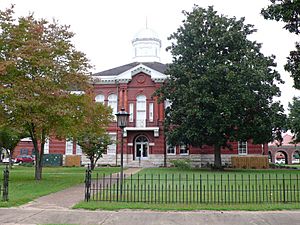Sumter County, Alabama facts for kids
Quick facts for kids
Sumter County
|
||
|---|---|---|

Sumter County Courthouse in Livingston
|
||
|
||

Location within the U.S. state of Alabama
|
||
 Alabama's location within the U.S. |
||
| Country | ||
| State | ||
| Founded | December 18, 1832 | |
| Named for | Thomas Sumter | |
| Seat | Livingston | |
| Largest city | Livingston | |
| Area | ||
| • Total | 913 sq mi (2,360 km2) | |
| • Land | 904 sq mi (2,340 km2) | |
| • Water | 9.4 sq mi (24 km2) 1.0% | |
| Population
(2020)
|
||
| • Total | 12,345 | |
| • Estimate
(2023)
|
11,727 |
|
| • Density | 13.521/sq mi (5.2206/km2) | |
| Time zone | UTC−6 (Central) | |
| • Summer (DST) | UTC−5 (CDT) | |
| Congressional district | 7th | |
|
||
Sumter County is a county located in the west central portion of Alabama. At the 2020 census, the population was 12,345. Its county seat is Livingston. Its name is in honor of General Thomas Sumter of South Carolina. The University of West Alabama is in Livingston.
Contents
History
Sumter County was established on December 18, 1832. From 1797 to 1832, Sumter County was part of the Choctaw Nation, which was made up of four main villages. The first settlers in Sumter County were French explorers who had come north from Mobile. They built and settled at Fort Tombecbee, near the modern-day town of Epes. In 1830, with the Treaty of Dancing Rabbit Creek, the Choctaw Indians ceded the land that is now Sumter County to the government.
Geography
According to the United States Census Bureau, the county has a total area of 913 square miles (2,360 km2), of which 904 square miles (2,340 km2) is land and 9.4 square miles (24 km2) (1.0%) is covered by water. It is intersected by the Noxubee River.
Major highways
 Interstate 20
Interstate 20 Interstate 59
Interstate 59 U.S. Route 11
U.S. Route 11 U.S. Route 80
U.S. Route 80 State Route 17
State Route 17 State Route 28
State Route 28 State Route 39
State Route 39 State Route 116
State Route 116
Adjacent counties
- Pickens County (north)
- Greene County (northeast)
- Marengo County (southeast)
- Choctaw County (south)
- Lauderdale County, Mississippi (southwest)
- Kemper County, Mississippi (west)
- Noxubee County, Mississippi (northwest)
Demographics
| Historical population | |||
|---|---|---|---|
| Census | Pop. | %± | |
| 1840 | 29,937 | — | |
| 1850 | 22,250 | −25.7% | |
| 1860 | 24,035 | 8.0% | |
| 1870 | 24,109 | 0.3% | |
| 1880 | 28,728 | 19.2% | |
| 1890 | 29,574 | 2.9% | |
| 1900 | 32,710 | 10.6% | |
| 1910 | 28,699 | −12.3% | |
| 1920 | 25,569 | −10.9% | |
| 1930 | 26,929 | 5.3% | |
| 1940 | 27,321 | 1.5% | |
| 1950 | 23,610 | −13.6% | |
| 1960 | 20,041 | −15.1% | |
| 1970 | 16,974 | −15.3% | |
| 1980 | 16,908 | −0.4% | |
| 1990 | 16,174 | −4.3% | |
| 2000 | 14,798 | −8.5% | |
| 2010 | 13,763 | −7.0% | |
| 2020 | 12,345 | −10.3% | |
| 2023 (est.) | 11,727 | −14.8% | |
| U.S. Decennial Census 1790–1960 1900–1990 1990–2000 2010–2020 |
|||
2020 Census
| Race / Ethnicity (NH = Non-Hispanic) | Pop 2000 | Pop 2010 | Pop 2020 | % 2000 | % 2010 | % 2020 |
|---|---|---|---|---|---|---|
| White alone (NH) | 3,813 | 3,304 | 2,937 | 25.77% | 24.01% | 23.79% |
| Black or African American alone (NH) | 10,718 | 10,283 | 8,955 | 72.43% | 74.71% | 72.54% |
| Native American or Alaska Native alone (NH) | 14 | 11 | 26 | 0.09% | 0.08% | 0.21% |
| Asian alone (NH) | 15 | 33 | 102 | 0.10% | 0.24% | 0.83% |
| Pacific Islander alone (NH) | 2 | 1 | 3 | 0.01% | 0.01% | 0.02% |
| Other race alone (NH) | 1 | 0 | 9 | 0.01% | 0.00% | 0.07% |
| Mixed race or Multiracial (NH) | 70 | 45 | 182 | 0.47% | 0.33% | 1.47% |
| Hispanic or Latino (any race) | 165 | 86 | 131 | 1.12% | 0.62% | 1.06% |
| Total | 14,798 | 13,763 | 12,345 | 100.00% | 100.00% | 100.00% |
As of the census of 2020, there were 12,345 people, 5,202 households, and 2,764 families residing in the county.
2010 census
As of the census of 2010, 13,763 people resided in the county. About 75.0% were Black or African American, 24.2% White, 0.2% Asian, 0.1% Native American, 0.2% of some other race, and 0.3% of two or more races; 0.6% were Hispanic or Latino (of any race).
Economy
Sumter County is part of the so-called Black Belt region of central Alabama. The region has suffered significant economic depression in recent years, but in April 2008, United States Steel announced plans to build at $150 million alloy plant near the community of Epes about 50 miles (80 km) southwest of Tuscaloosa, Alabama.
The plant would require 250 workers to construct in a town of only 206. Up to 235 full-time jobs would be created when completed, with jobs paying about $50,000 annually. The state of Alabama offered $28 million in incentives to get the plant located in Sumter County. The plant would make use of a new technology that produces a carbon alloy for use in steel making at the U.S. Steel plant in Fairfield, Alabama near Birmingham. At the time of the announcement, the unemployment rate in Sumter County was 6.1%.
In November 2008, U.S. Steel spokesman D. John Armstrong announced that plans to build the Epes facility had been placed on hold. “We’ve adjusted the timing of it, and we don’t know what the new timeline will be,” he said. “We’ve delayed construction, but we have not cancelled it.“
To date, the Epes facility has not been built.
From 2009 to 2013, the county had a median household income of $22,186 compared to a state figure of $45,253, making it the poorest county in the state. By 2015, Sumter County remained the poorest county in Alabama, with a median household income of $19,501 in comparison to the state median household income of $43,623.
Education
Colleges and universities
The University of West Alabama is in Livingston.
Primary and secondary schools
The school district serving the county is Sumter County School District. In addition, a charter school is located on the campus of the University of West Alabama, University Charter School.
Until 2017, all schools in Sumter County were in practice entirely racially segregated, as white parents sent their children to Sumter Academy, a private segregation academy set up in 1970 in the wake of a federal court ruling ordering the school district to desegregate. During the 2015–16 school year, 98% of the 1,593 students in county's public schools were black, while none of the 170 students at Sumter Academy were black. However, Sumter Academy closed in June 2017, while in August 2018, University Charter School opened, with a half-black, half-white enrollment, making it the county's first practically desegregated school.
Communities
Cities
- Livingston (county seat)
- York
Towns
Census-designated places
Unincorporated communities
- Belmont
- Coatopa
- Intercourse
- Payneville
- Sumterville
- Ward
- Warsaw
Places of interest
Sumter County is home to the University of West Alabama Outdoor Sculpture Exhibition in Livingston and the Coleman Center for the Arts in York, Alabama. The historic Alamuchee-Bellamy Covered Bridge is also located on the University of West Alabama campus.
Notable residents
- Austin Armstrong (born 1993), football coach, born and raised in York, Alabama
- Jaybird Coleman (1896–1950), country blues harmonica player, vocalist, and guitarist
- Mentor Dotson (c. 1837–?), Black state legislator who represented Sumter County, Alabama in the Alabama House of Representatives from 1872–1874
- Maria Fearing (1838–1937), Black educator and Presbyterian missionary to Congo, who was born on Winston's Oak Hill Plantation in Sumter County
- Carol Forman (1919–1997), actress
- Amelia Greenwald, International nurse, and first female driver in Poland
- Lena King Lee (1906–2006), Black educator, attorney, and politician; the first Black women elected to the Maryland General Assembly
See also
 In Spanish: Condado de Sumter (Alabama) para niños
In Spanish: Condado de Sumter (Alabama) para niños


